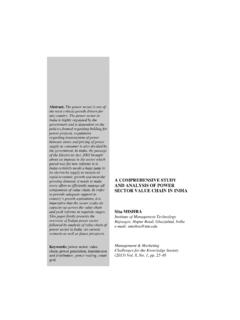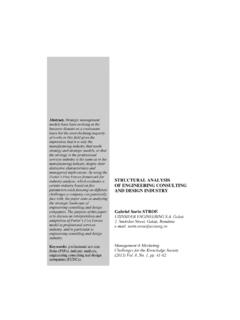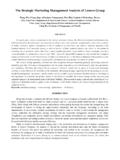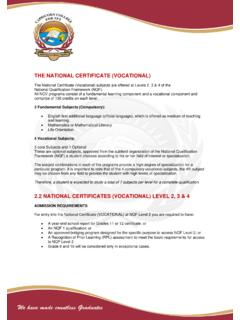Transcription of Management & Marketing Challenges for the …
1 Abstract. The purpose of this descriptive research is to present what kind of corporate social responsibility (CSR) activities English football clubs are implementing. The paper was designed by approaching the examples of the twenty clubs playing in the 2010-2011 season of the Premier League. A key finding is that football clubs are not only interested in the sporting outcome on the field, but they are also aware of their social status. An implication of this research would be to encourage academics to research more upon the use of CSR in professional sports, as there is a lack of literature regarding this topic. Diminishing the lack was the reason why sport has been chosen as an example, while the reason for selecting English clubs as case studies is backed up by the fact that these organizations have some of the most developed CSR programs in European sport.
2 Limitations of the paper are that it does not offer financial implications of running CSR programs, nor does it trace very deep the implications of the programs on individuals. The originality of the research is provided by the combination between CSR and football, resulting in a topic that few academics have been concerned with researching. Keywords: community, English football, Football CSR, football Management , Premier League, sport business. CORPORATE SOCIAL RESPONSIBILITY IN ENGLISH FOOTBALL: HISTORY AND PRESENT Vlad RO CA Academy of Economic Studies, Bucharest Pia a Roman no. 6, Bucharest, Rom nia e-mail: Management & Marketing Challenges for the Knowledge Society (2011) Vol. 6, No. 2, pp. 327-346 Management & Marketing 3281. Introduction Football clubs (FCs) aren t only interested in how to win matches at all cost, but, as Nick Hornby writes, they also owe a sense of decency to their fans (Arsenal Community Review, p.)
3 3). Football clubs have a privileged position (PP) in the community, being institutions that can very good and easy represent the community to which they belong. A football club is an ambassador of its community, representing it through the results on the pitch and the activities outside the playing field, and, more important, it is an identification vehicle for the citizens. Alexander Colin Wynn (2007, p. 4) writes the following about football: Clubs from towns, cities or regions command the hearts and minds of their fans. Each club, so its followers believe, embodies the local character, traditions and spirit that define the community. [..] Football teams can be fashioned to reflect local and national ideologies, characteristics, spirits, beliefs, practices, and symbols that constitute cultures . Whatever its sporting results, a football club cannot remain uninfluenced by the society, by the local community.
4 In its activity, the club takes over values of the community of which it is a member and reproduces them onto the football pitch or in each ever other activities it runs. If the football club is involved in the community/civil society otherwise than just simply producing football matches for the fans to watch, then the privileged position offers a one of a kind power to engage people. Due to the PP a strong link between the FC and its community is created. Because fans show their support for the club, the club chooses to pay them back with something more than the game of football. The club offers to help the community through various educational, health or social inclusion programs, as well as through charity. When the club does so, citizens are thankful, and due to the strong bound between the two parties, the latter ones even show their support to the cause.
5 Because, as well as the citizens, the football club is a member and a driving force of the community. Being part of a knowledge-based society (Br tianu & Orzea, 2010) football clubs have to develop expertise not just on the playing field, but also through external activities, such as CSR. 2. Literature and Methodology The first step of this descriptive research consisted in reading and analyzing literature concerning corporate social responsibility, in order to identify patterns of action. Some of the latest articles on various topics (Bibu et al., 2010; Mitra & Borza, 2010; Olaru et al., 2011; Sova et al., 2011; Smeureanu et al., 2011; erban & Kaufmann, 2011) provided valuable information for starting to create a model suitable for researching the social implications of football clubs. In recent years, CSR has attracted the attention of many researchers, but the topics were focused on business sectors such as constructions, manufacturing, metallurgical industry (Ciora & Anica-Popa, 2011), banking (Dumitru et al.)
6 , 2011), accounting (Albu et al., 2011), education (Deaconu et al., 2011; Radu et al. 2011), environment (Gr dinaru Corporate social responsibility in English football: history and present 329& Ignat, 2008), chemical industry (Todd, 2009) or telecommunications (Gogonea , 2011), rather than on sports. Therefore, the originality of the article is given by the combination of CSR and football. Although sport is a business upon which intense scientific research has been done, there is a lack in what concerns the literature about the corporate social responsibility of the sporting organizations. Just few authors have researched about the community implications of sport clubs (Misener & Mason, 2009; Heere & James, 2007; Siegfried & Zimbalist, 2000; Noll & Zimbalist, 1997; Fl ysand & Jakobsen, 2007; Sparvero & Chalip, 2007) and even fewer about their social responsibilities (Godfrey, 2009; Babiak & Wolfe, 2006; Brietbarth & Harris, 2008; Genzale, 2006; Smith & Westerbeek, 2007).
7 According to Walker & Parent (2010, p. 199), a cause for the lack of research about corporate social responsibility in sport is that the broader Management literature has not tried to develop social involvement models for a particular industry, such as sport. The literature offers a high quality theory of the CSR, but just at a general level, applicable to different industries. However, set in practice, a CSR program may differ from one industry to another. As part this research specialization, the aforementioned works on CSR in sport were analyzed. The gathered knowledge was useful in designing the seven programs model used for this study. After studying the academic literature, a further step was to gather information about the CSR programs of Premier League clubs. Thus, the focus was set on the particular case study that was chosen, trying to identify specific patterns of CSR in English football.
8 As large interest media such as local, national, or, even international newspapers or televisions did not offer too much and detailed information about the CSR activities of the football clubs, the best informational support to collect the necessary insider data proved to be official websites of the clubs, which largely communicated the community dedication of the clubs (Briebarth & Harris, 2008). Even though the structure of the sites and the quantity and quality of the pieces of information offered varied from a club to another (Walker & Parent, 2010), the Internet webpage communication channels were chosen because they offered official, unaltered, information. Next to CSR news, the websites of the clubs offer active community information (Esrock & Leichty, 1998) for the visitors who really want to find out what initiatives the FCs have.
9 Thus, the research was performed with information accumulated from secondary sources, which have been found on the Internet. Then, the contents of CSR activities in the football clubs were compared, which led to making a decision regarding which pieces information are useful to analyze (Krippendorff, 1980), bearing in mind the purpose of this paper. After the comparison, a synthesis was made. This was the ignition for the presentation of the cases. The research was limited at the twenty clubs of the 2010-2011 Premier League season, having the objective to give an insight of the CSR involvement of the English FCs, as the practices are similar at other league clubs too, just that the degree of involvement is different from club to club, depending on the financial and material power of the FC and its representativeness in the community, but also by the Management & Marketing 330dimensions and the characteristics of the community.
10 Another purpose of the article would be to represent a starting point for further academic research regarding CSR in sport. The social implication of sports clubs was classified by Walker & Parent (2010, p. 203) in different types of programs. The classification was helpful in creating the seven program types which are going to be used in this research, in order to categorize the CSR activities of the analyzed football clubs: 1) Educational Programs (EP), 2) Sport Programs (SP - Advance Amateur Football and Amateur Sport Programs), 3) Social Inclusion Programs (SIP), 4) Cultural Integration Programs (CIP), 5) Family Programs (FP), 6) Health Programs (HP), 7) Charity Programs (CP). Although some of the community activities of the clubs could have been classified into other program types as well, like for example Gender Equality Programs or Poverty Reduction Programs, a concentration upon the seven mentioned programs offered a better insight and a better understanding of how FCs are socially responsible.











